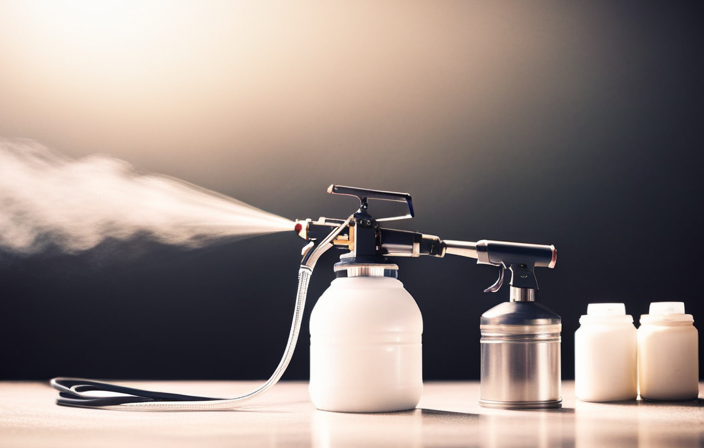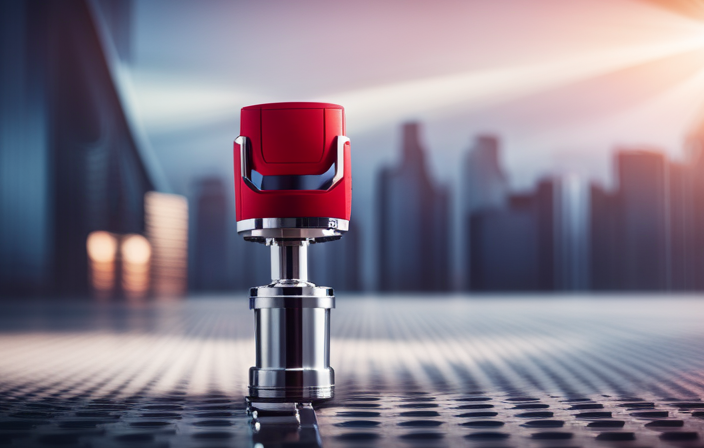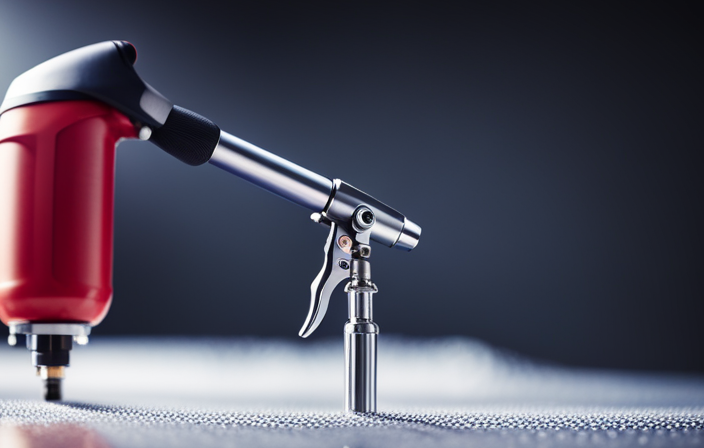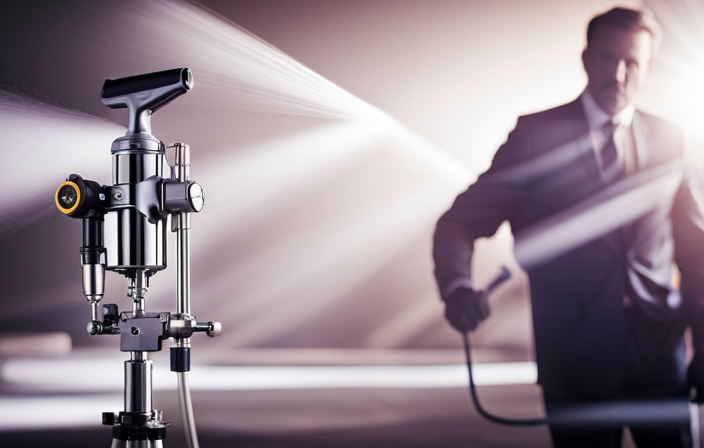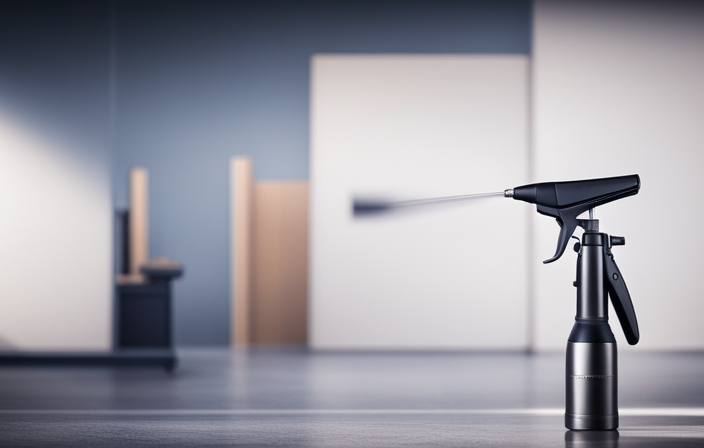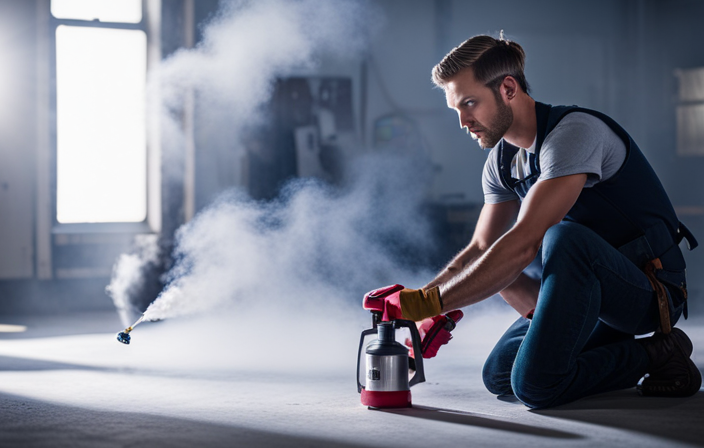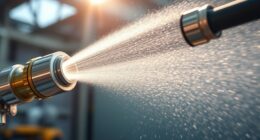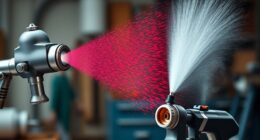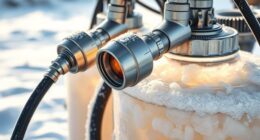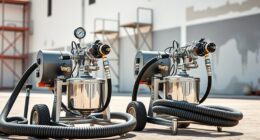As a professional painter, I have always believed that a good brush and roller were all I needed to get the job done. However, trying out an airless paint sprayer recently has completely changed my outlook. It’s like using a magic paintbrush that can cover large areas in a fraction of the time.
But here’s the thing: not all paints are compatible with an airless paint sprayer. That’s why I decided to dive deep into the world of paint types and find out which ones work best with this innovative tool. In this article, I’ll be exploring the different types of paint that can be used with an airless paint sprayer, from latex and oil-based paints to acrylics and enamels.
So whether you’re a DIY enthusiast or a professional painter, get ready to discover the perfect paint for your airless paint sprayer.
Key Takeaways
- Chalk paint is popular for furniture and decorative projects, providing a matte finish and vintage look.
- Epoxy paint offers durability, chemical resistance, and easy maintenance, and can be used as a base coat for metallic finishes.
- Metallic paint adds elegance and sophistication to any surface, and using the correct nozzle size and adjusting pressure ensures a stunning and professional finish.
- When using an airless paint sprayer, it is important to follow the manufacturer’s instructions carefully, properly prepare the surface, and choose high-quality paint designed for specific surfaces.
Latex Paint
You can totally use an airless paint sprayer with latex paint! There are several advantages of using latex paint with an airless paint sprayer. First, latex paint is water-based, which means it dries quickly and has a low odor. This makes it easier to work with and allows for faster completion of painting projects.
Additionally, latex paint is more resistant to cracking, peeling, and fading compared to oil-based paint.
To achieve a smooth finish with latex paint using an airless paint sprayer, here are a few tips. First, make sure to properly thin the paint according to the manufacturer’s instructions. This will ensure that the paint flows smoothly through the sprayer. Second, adjust the spray pattern and pressure to achieve an even coat of paint. Finally, always clean the sprayer thoroughly after each use to prevent clogs and maintain its performance.
Now, let’s move on to discussing oil-based paint.
Oil-Based Paint
Oil-based paint is perfect for an airless sprayer, providing a smooth and seamless finish. When using an airless paint sprayer with oil-based paint, there are several advantages to consider.
First, airless sprayers allow for faster application, saving time and effort. The high pressure of the sprayer atomizes the paint, resulting in a fine mist that evenly coats the surface. This ensures a professional-looking finish without brush or roller marks.
Second, oil-based paint is known for its durability and resistance to wear and tear. It is ideal for surfaces that require high durability, such as metal or wood. The airless sprayer allows for precise and even coverage, ensuring that every nook and cranny is properly coated.
Lastly, when using oil-based paint with an airless sprayer, there are a few tips to keep in mind. Make sure to thin the paint according to the manufacturer’s instructions to achieve the desired consistency. Additionally, clean the sprayer thoroughly after each use to prevent buildup and maintain its performance.
Transitioning to the next section, acrylic paint offers its own unique advantages when used with an airless sprayer.
Acrylic Paint
Transitioning to the next section, acrylic paint brings its own unique advantages when used with an airless sprayer, allowing you to effortlessly achieve a flawless and professional finish. Acrylic paint is a popular choice due to its quick drying time and versatility. When using acrylic paint with an airless paint sprayer, you can enjoy several advantages. Firstly, acrylic paint is water-based, making it easy to clean up and environmentally friendly. Secondly, it has excellent adhesion properties, ensuring that the paint adheres well to various surfaces. Lastly, it provides a smooth and even finish, eliminating brush marks and leaving a professional look. To achieve a smooth finish with acrylic paint and an airless sprayer, follow these tips: 1) Use a low-pressure setting on the sprayer to avoid overspray. 2) Thin the paint with water as per the manufacturer’s instructions for better atomization. 3) Maintain a consistent spraying distance and speed. 4) Apply multiple thin coats rather than a single heavy coat. 5) Always clean the sprayer thoroughly after use to prevent clogging. Transitioning into the subsequent section about enamel paint, it is important to understand the unique properties and techniques associated with this type of paint.
Enamel Paint
Get ready to discover the stunning qualities of enamel paint and how it can elevate your painting projects to a whole new level. Enamel paint, known for its durable and glossy finish, is a popular choice for various applications. Its application techniques differ from other types of paint, as it requires careful preparation and a properly calibrated airless paint sprayer. The high viscosity of enamel paint may require thinning with a suitable solvent before spraying, ensuring a smooth and even coat.
While enamel paint offers excellent durability and resistance to wear and tear, it can be challenging to clean up due to its oil-based composition. Additionally, the strong fumes emitted during application can be harmful if proper ventilation is not maintained.
Transitioning into the subsequent section, let’s explore the benefits of water-based paint for a more eco-friendly alternative.
Water-Based Paint
You may think that water-based paint is just a simple alternative, but prepare to be amazed by its impressive durability and stunning finish. When it comes to application techniques, water-based paint can be easily sprayed using an airless paint sprayer. The key is to ensure that the paint is properly thinned to achieve the desired consistency for spraying.
One of the major benefits of using water-based paint with an airless sprayer is the ease of cleanup. Unlike oil-based paints, water-based options can be easily cleaned up with soap and water. Additionally, water-based paints emit fewer fumes and have a faster drying time compared to their oil-based counterparts.
However, it’s important to note that water-based paints may not provide the same level of durability and adhesion as enamel or oil-based paints. Despite this drawback, water-based paint is still a popular choice for many DIY projects.
Moving on to stain…
Stain
Stain is the perfect choice for adding a touch of natural beauty and depth to your wood surfaces. It enhances the grain and texture, while protecting the wood from moisture and UV damage. When using an airless paint sprayer, it’s important to select a stain that’s compatible with the sprayer.
Here are three key things to consider when using stain with an airless paint sprayer:
-
Stain removal techniques: Before applying the stain, it’s crucial to prepare the surface properly. This includes removing any existing stain or finish. There are various techniques available for stain removal, such as sanding or using a chemical stripper.
-
Best stain colors for different surfaces: Stains come in a wide range of colors, from light and natural to dark and rich. The best stain color will depend on the type of wood and the desired aesthetic. For example, lighter stains work well on pine, while darker stains can enhance the beauty of oak or mahogany.
-
Proper application: When using an airless paint sprayer, it’s important to follow the manufacturer’s instructions for dilution ratios and spray settings. This will ensure an even and smooth application of the stain, without any streaks or drips.
Transitioning into the subsequent section about ‘primer’, it’s essential to first apply a primer before painting to ensure proper adhesion and coverage.
Primer
Prepare for a wild ride as we delve into the world of primer, a magical potion that ensures your paint job sticks like glue and covers like a dream.
When using an airless paint sprayer, applying primer has its advantages and disadvantages. One advantage is that it provides a smooth and even surface for the paint to adhere to, resulting in a professional-looking finish. Additionally, primer helps to seal porous surfaces, prevents stains from bleeding through, and improves the durability of the paint.
However, using primer with an airless paint sprayer can be challenging as it requires careful technique and control to achieve an even application. To achieve a smooth finish, it’s essential to maintain the correct spraying distance, use the appropriate nozzle size, and apply multiple thin coats rather than one thick coat.
Transitioning into the next section about ‘chalk paint,’ it’s important to note that primer isn’t always necessary when using this type of paint.
Chalk Paint
When it comes to using an airless paint sprayer, it’s important to consider the type of paint you’re using. In the previous section, we discussed the application of primer.
Now, let’s dive into the world of chalk paint. Chalk paint is a popular choice for furniture and decorative projects because of its matte finish and vintage look. When using an airless paint sprayer with chalk paint, it’s crucial to thin the paint to the manufacturer’s recommended consistency for optimal spray performance. Additionally, it’s recommended to use a larger tip size to accommodate the thicker consistency of chalk paint.
Some of the best brands for chalk paint include Annie Sloan, Rust-Oleum, and Dixie Belle. These brands offer a wide range of colors and finishes, allowing you to achieve the desired look for your project.
Now, let’s move on to the next section where we’ll explore the application of epoxy paint.
Epoxy Paint
To achieve a professional and durable finish with epoxy paint, you’ll need to follow the manufacturer’s instructions carefully.
Epoxy paint is a popular choice for industrial applications due to its many benefits. Here are some tips for achieving a smooth finish with epoxy paint:
-
Proper surface preparation is crucial. Make sure the surface is clean, dry, and free of any contaminants.
-
Use a high-quality epoxy paint that’s specifically designed for the type of surface you’re painting.
-
Apply the paint in thin and even coats to avoid drips and uneven coverage.
-
Allow each coat to dry completely before applying the next coat.
-
Use a high-quality brush or roller to apply the paint for better control and coverage.
Using epoxy paint for industrial applications offers benefits such as excellent durability, chemical resistance, and easy maintenance.
Transitioning to the next section about metallic paint, it’s important to note that epoxy paint can also be used as a base coat for metallic finishes.
Metallic Paint
With its shimmering allure, metallic paint adds a touch of elegance and sophistication to any surface.
When using an airless paint sprayer for metallic paint, there are a few techniques to keep in mind. First, it’s crucial to use the correct nozzle size. A smaller nozzle, such as a 0.011 to 0.015 inch, will help achieve a finer finish and prevent clogging.
Additionally, adjusting the pressure to a lower setting will help control the flow of the metallic paint and minimize overspray.
As for the best metallic paint brands, some popular choices include Rust-Oleum, Modern Masters, and Benjamin Moore. These brands offer a wide range of metallic colors and provide excellent coverage and durability.
Overall, when using an airless paint sprayer for metallic paint, following these techniques and using high-quality brands will ensure a stunning and professional finish.
Frequently Asked Questions
Can an airless paint sprayer be used with textured or rough surfaces?
Yes, an airless paint sprayer can be used on textured or rough surfaces. However, caution should be exercised when using it on delicate surfaces, as the high pressure can cause damage. It is also commonly used for exterior surfaces.
What precautions should be taken when using an airless paint sprayer with oil-based paint?
When using an airless paint sprayer with oil-based paint, it is important to take proper precautions and safety measures. One key precaution is to ensure proper ventilation to avoid inhaling harmful fumes.
Are there any specific types of primers that should be used with an airless paint sprayer?
When using an airless paint sprayer, it is important to choose the right primer. There are various types of primers available for the airless paint sprayer, such as oil-based primers, water-based primers, and shellac-based primers. Each type has its own benefits and is suitable for different surfaces. The airless paint sprayer provides efficient and even coverage, making it an excellent choice for priming. It saves time and ensures a smooth and durable finish.
Can an airless paint sprayer be used to apply paint on furniture or other small objects?
Yes, an airless paint sprayer can be used to apply paint on furniture or other small objects. However, when using an airless paint sprayer for detailed work or on delicate surfaces, it is important to use low-pressure settings and proper technique to avoid overspray and damage.
Is it necessary to thin the paint before using it with an airless paint sprayer?
Yes, it is necessary to thin the paint before using it with an airless paint sprayer. The paint viscosity and consistency need to be adjusted to ensure proper atomization and smooth application through the sprayer.
Conclusion
After exploring the various types of paint that can be used with an airless paint sprayer, it becomes clear that these powerful tools have the capability to handle a wide range of paint options.
From the versatile latex paint to the durable oil-based paint, and even the vibrant metallic paint, the possibilities are endless.
Just like the paint sprayer itself, these paint types symbolize creativity, transformation, and the ability to bring new life to any surface.
So whether you’re a professional painter or a DIY enthusiast, the airless paint sprayer is a valuable tool that can help you achieve remarkable results.
